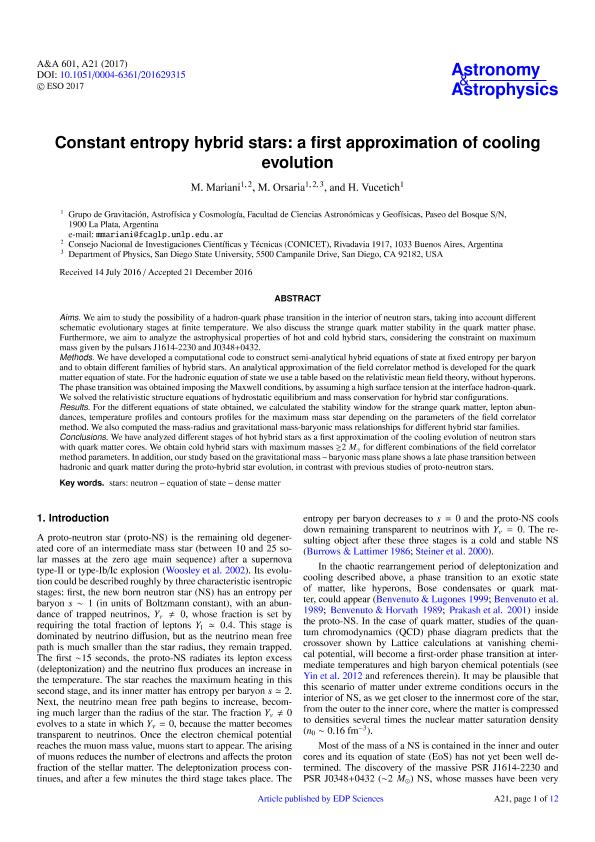Mostrar el registro sencillo del ítem
dc.contributor.author
Mariani, Mauro

dc.contributor.author
Orsaria, Milva Gabriela

dc.contributor.author
Vucetich, Hector

dc.date.available
2018-06-22T17:33:27Z
dc.date.issued
2017-05
dc.identifier.citation
Mariani, Mauro; Orsaria, Milva Gabriela; Vucetich, Hector; Constant entropy hybrid stars: A first approximation of cooling evolution; EDP Sciences; Astronomy and Astrophysics; 601; 5-2017; 1-12; A21
dc.identifier.issn
0004-6361
dc.identifier.uri
http://hdl.handle.net/11336/49661
dc.description.abstract
Aims. We aim to study the possibility of a hadron-quark phase transition in the interior of neutron stars, taking into account different schematic evolutionary stages at finite temperature. We also discuss the strange quark matter stability in the quark matter phase. Furthermore, we aim to analyze the astrophysical properties of hot and cold hybrid stars, considering the constraint on maximum mass given by the pulsars J1614-2230 and J0348+0432. Methods. We have developed a computational code to construct semi-analytical hybrid equations of state at fixed entropy per baryon and to obtain different families of hybrid stars. An analytical approximation of the field correlator method is developed for the quark matter equation of state. For the hadronic equation of state we use a table based on the relativistic mean field theory, without hyperons. The phase transition was obtained imposing the Maxwell conditions, by assuming a high surface tension at the interface hadron-quark. We solved the relativistic structure equations of hydrostatic equilibrium and mass conservation for hybrid star configurations. Results. For the different equations of state obtained, we calculated the stability window for the strange quark matter, lepton abundances, temperature profiles and contours profiles for the maximum mass star depending on the parameters of the field correlator method. We also computed the mass-radius and gravitational mass-baryonic mass relationships for different hybrid star families. Conclusions. We have analyzed different stages of hot hybrid stars as a first approximation of the cooling evolution of neutron stars with quark matter cores. We obtain cold hybrid stars with maximum masses ≥2 M⊙ for different combinations of the field correlator method parameters. In addition, our study based on the gravitational mass – baryonic mass plane shows a late phase transition between hadronic and quark matter during the proto-hybrid star evolution, in contrast with previous studies of proto-neutron stars.
dc.format
application/pdf
dc.language.iso
eng
dc.publisher
EDP Sciences

dc.rights
info:eu-repo/semantics/openAccess
dc.rights.uri
https://creativecommons.org/licenses/by-nc-sa/2.5/ar/
dc.subject
Dense Matter
dc.subject
Equation of State
dc.subject
Stars: Neutron
dc.subject.classification
Astronomía

dc.subject.classification
Ciencias Físicas

dc.subject.classification
CIENCIAS NATURALES Y EXACTAS

dc.title
Constant entropy hybrid stars: A first approximation of cooling evolution
dc.type
info:eu-repo/semantics/article
dc.type
info:ar-repo/semantics/artículo
dc.type
info:eu-repo/semantics/publishedVersion
dc.date.updated
2018-06-21T13:00:41Z
dc.journal.volume
601
dc.journal.pagination
1-12; A21
dc.journal.pais
Francia

dc.description.fil
Fil: Mariani, Mauro. Universidad Nacional de La Plata. Facultad de Ciencias Astronómicas y Geofísicas; Argentina. Consejo Nacional de Investigaciones Científicas y Técnicas; Argentina
dc.description.fil
Fil: Orsaria, Milva Gabriela. Universidad Nacional de La Plata. Facultad de Ciencias Astronómicas y Geofísicas; Argentina. Consejo Nacional de Investigaciones Científicas y Técnicas; Argentina. San Diego State University; Estados Unidos
dc.description.fil
Fil: Vucetich, Hector. Universidad Nacional de La Plata. Facultad de Ciencias Astronómicas y Geofísicas; Argentina. Consejo Nacional de Investigaciones Científicas y Técnicas; Argentina
dc.journal.title
Astronomy and Astrophysics

dc.relation.alternativeid
info:eu-repo/semantics/altIdentifier/url/https://www.aanda.org/articles/aa/abs/2017/05/aa29315-16/aa29315-16.html
dc.relation.alternativeid
info:eu-repo/semantics/altIdentifier/doi/http://dx.doi.org/10.1051/0004-6361/201629315
Archivos asociados
